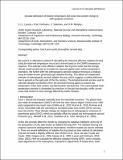Decadal Attribution of Historic Temperature and Ocean Heat Content Change to Anthropogenic Emissions
Author(s)
Larson, E. J. L.; Portmann, R. W.; Solomon, Susan; Murphy, D. M.
DownloadAccepted version (398.2Kb)
Open Access Policy
Open Access Policy
Creative Commons Attribution-Noncommercial-Share Alike
Terms of use
Metadata
Show full item recordAbstract
We present an alternative method of calculating the historical effective radiative forcing using the observed temperature record and a kernel based on the 5th Climate Model Intercomparison Project (CMIP5) temperature response. This estimate is the effective radiative forcing time series that the average climate model would need to simulate the observed global mean surface temperature anomalies. We further infer the anthropogenic aerosols radiative forcing as a residual using the better-known greenhouse gas radiative forcing. This allows an independent estimate of anthropogenic aerosol radiative forcing, which suggests a cooling influence due to aerosols in the early part of the twentieth century. The temporal kernels are also used to calculate decadal contributions from the dominant forcing agents to present-day temperature, ocean heat content, and thermosteric sea level rise. The current global mean temperature anomaly is dominated by emissions in the past two decades, while current ocean heat content is more strongly affected by earlier decades.
Date issued
2020-02Department
Massachusetts Institute of Technology. Department of Earth, Atmospheric, and Planetary SciencesJournal
Geophysical Research Letters
Publisher
American Geophysical Union (AGU)
Citation
Larson, E. J. L. et al. "Decadal Attribution of Historic Temperature and Ocean Heat Content Change to Anthropogenic Emissions." Geophysical Research Letters 47, 3 (February 2020): e2019GL085905 © 2020 American Geophysical Union
Version: Author's final manuscript
ISSN
0094-8276
1944-8007